The Impact of the Climate Action Programme 2030 and Federal State Measures on the Uptake of Renewable Heating Systems in Lower Saxony’s Building Stock
Abstract
1. Introduction
2. Methodology: The SDA Model
2.1. Model Assumptions
2.2. Building Stock
2.3. Heating Systems
2.4. Energy Consumption, Efficiency and Emissions
2.5. Economic Evaluation for Decision-Making
2.6. Investment Costs
2.7. Fuel Costs
2.8. Operational Costs
2.9. Modelled Scenarios
3. Results
3.1. Sensitivity Analysis
3.2. Potential Subsidy Schemes for Lower Saxony
3.3. Primary Energy Consumption, Final Energy Consumption and CO2e-Emissions
3.4. Distribution of Technologies
4. Discussion and Conclusions
4.1. General Discussion
4.2. Policy Recommendations
Author Contributions
Funding
Conflicts of Interest
Appendix A. Cost Functions
Appendix B. Details of the First Two Modeled Scenarios BAU-Scenario
- MAP subsidies that apply for renewable heating systems, i.e., heat pumps, thermal solar collectors and pellet systems. For small houses, they are lump sump payments that differ depending on the technology. However, when the boilers or solar thermal collectors cross specific size related thresholds, the payments are dependent on either heating load or square footage in the case of solar thermal collectors. Therefore, the heating load was calculated through the useful energy consumption and full heating hours [84]. The square footage of the thermal collector had to be estimated using a formula by Acker [85] through the average amount of people living in the house.
- The KfW-Program promotes individual measures, like the exchange of a heating system, with a grant of 10% of the investment costs. In the model, the program applies to gas and oil heating systems, including those which are combined solar thermal collectors.
- The newly introduced carbon price for the building sector, which are introduced in 2021 and increase gradually until 2025. For the year 2026, a range between 55 and 65 Euros per tonne of CO2e is intended which was simplified by the arithmetic mean, 60 Euros. This was further used for the remaining time frame of the model, since predictions are bound to a great amount of uncertainty. It is furthermore assumed that the consumer bears the complete costs.
- The MAP grants, which have been restructured and simplified. The most crucial alteration has been the shift from lump sum payments to grants that cover a specific percentage of the investment costs. They apply to all renewable heating systems as well has gas hybrid systems. If it is an oil boiler that is replaced, the covered percentage increases considerably, serving as the stipulated proposed ‘oil boiler exchange premium’ [77].
- The ban on oil boilers as of 2026. From this date on, oil heating technologies is no longer an option in the model.
- The increase in requirements for solar thermal collectors. They have to cover at least 25% of the heating load to receive the support under the amendment [77], which is roughly double in comparison to the scenario before. The investment costs were adjusted accordingly by including an adjustment factor of 1,5, derived from the real life calculations of Schmitz [86].
Appendix C. Results Sensitivity Analysis
| Change in Price Progression | Achieved Emission Reduction 2020–2035 | ||
| Oil and Gas | Pellet Prices | Electricity Prices | |
| 20% less increase | −26.48% | −32.11% | −30.37% |
| 10% less increase | −27.09% | −30.40% | −28.53% |
| ‘Climate Package Scenario’ | −28.65% | −28.65% | −28.65% |
| 10% more increase | −31.49% | −27.57% | −28.61% |
| 20% more increase | −33.22% | −27.36% | −28.61% |
| CO2-Prices | Achieved Emission Reduction (2020–2035) |
| 10 €/t lower | −28.14% |
| ‘Climate Package Scenario’ | −28.65% |
| 10 €/t higher | −29.36% |
| 20 €/t higher | −30.14% |
| Trajectory of Wagner et al. | −30.90% |
| 150 €/t from the starting point | −35.96% |
| Comprehensive Refurbishment Rate | Achieved Emission Reduction (2020–2035) |
| 0% | −28.54% |
| ‘Climate Package Scenario’ | −28.65% |
| 0.33% | −28.86% |
| 0.53% | −29.07% |
| 0.73% | −29.28% |
| Implicit Discount Rate | Achieved Emission Reduction (2020–2035) |
| 9.5% | −29.25% |
| ‘Climate Package Scenario’ | −28.65% |
| 18% | −26.45% |
| 25% | −23.97% |
| 30% | −23.10% |
| 36% | −22.63% |
Appendix D. Share of Technologies in the Different Scenarios
| 2020 | 2021 | 2022 | 2023 | 2024 | 2025 | 2026 | 2027 | 2028 | 2029 | 2030 | 2031 | 2032 | 2033 | 2034 | 2035 | |
|---|---|---|---|---|---|---|---|---|---|---|---|---|---|---|---|---|
| District heating | 4.42% | 4.42% | 4.42% | 4.42% | 4.42% | 4.42% | 4.42% | 4.42% | 4.42% | 4.42% | 4.42% | 4.42% | 4.42% | 4.42% | 4.42% | 4.42% |
| Gas CB | 36.71% | 38.71% | 40.75% | 43.50% | 46.98% | 50.46% | 52.70% | 54.93% | 57.16% | 59.39% | 61.63% | 62.99% | 64.36% | 65.72% | 67.09% | 68.45% |
| Gas low.-temp. | 33.10% | 31.78% | 30.47% | 28.74% | 26.61% | 24.48% | 23.06% | 21.64% | 20.22% | 18.80% | 17.38% | 16.43% | 15.49% | 14.54% | 13.60% | 12.66% |
| Oil CB | 10.13% | 9.78% | 9.39% | 8.88% | 8.24% | 7.60% | 7.18% | 6.76% | 6.33% | 5.90% | 5.47% | 5.19% | 4.90% | 4.61% | 4.32% | 4.04% |
| Oil low.-temp. | 9.13% | 8.77% | 8.41% | 7.93% | 7.34% | 6.75% | 6.36% | 5.97% | 5.58% | 5.19% | 4.79% | 4.53% | 4.27% | 4.01% | 3.75% | 3.49% |
| Air HP | 2.10% | 2.02% | 1.94% | 1.83% | 1.69% | 1.56% | 1.47% | 1.38% | 1.28% | 1.19% | 1.10% | 1.04% | 0.98% | 0.92% | 0.86% | 0.80% |
| Geothermal HP | 0.31% | 0.30% | 0.29% | 0.27% | 0.25% | 0.23% | 0.22% | 0.20% | 0.19% | 0.18% | 0.16% | 0.16% | 0.15% | 0.14% | 0.13% | 0.12% |
| Pellets | 4.10% | 3.94% | 3.78% | 3.56% | 3.30% | 3.03% | 2.86% | 2.68% | 2.51% | 2.33% | 2.15% | 2.04% | 1.92% | 1.80% | 1.69% | 1.57% |
| Pellets/ solar WH | 0.00% | 0.29% | 0.57% | 0.87% | 1.17% | 1.47% | 1.76% | 2.04% | 2.32% | 2.60% | 2.89% | 3.20% | 3.52% | 3.83% | 4.14% | 4.46% |
| 2020 | 2021 | 2022 | 2023 | 2024 | 2025 | 2026 | 2027 | 2028 | 2029 | 2030 | 2031 | 2032 | 2033 | 2034 | 2035 | |
|---|---|---|---|---|---|---|---|---|---|---|---|---|---|---|---|---|
| District heating | 4.42% | 4.42% | 4.42% | 4.42% | 4.42% | 4.42% | 4.42% | 4.42% | 4.42% | 4.42% | 4.42% | 4.42% | 4.42% | 4.42% | 4.42% | 4.42% |
| Gas CB | 36.71% | 36.54% | 36.34% | 35.79% | 34.98% | 34.17% | 33.59% | 32.57% | 31.48% | 30.39% | 29.29% | 28.53% | 27.74% | 26.96% | 26.18% | 25.40% |
| Gas low-temp. | 33.10% | 31.78% | 30.47% | 28.74% | 26.61% | 24.48% | 23.06% | 21.64% | 20.22% | 18.80% | 17.38% | 16.43% | 15.49% | 14.54% | 13.60% | 12.66% |
| Gas CB/ Solar WH | 0.00% | 2.08% | 4.08% | 6.71% | 10.15% | 13.59% | 15.82% | 18.40% | 20.99% | 23.59% | 26.15% | 27.73% | 29.34% | 30.94% | 32.49% | 34.04% |
| Oil CB | 10.13% | 9.73% | 9.33% | 8.80% | 8.14% | 7.49% | 7.06% | 6.62% | 6.19% | 5.75% | 5.32% | 5.03% | 4.74% | 4.45% | 4.16% | 3.87% |
| Oil low-temp. | 9.13% | 8.77% | 8.41% | 7.93% | 7.34% | 6.75% | 6.36% | 5.97% | 5.58% | 5.19% | 4.79% | 4.53% | 4.27% | 4.01% | 3.75% | 3.49% |
| Air HP | 2.10% | 2.14% | 2.28% | 2.84% | 3.55% | 4.26% | 4.71% | 5.23% | 5.70% | 6.15% | 6.61% | 6.73% | 6.84% | 6.95% | 7.06% | 7.16% |
| Geothermal HP | 0.31% | 0.30% | 0.29% | 0.27% | 0.25% | 0.23% | 0.22% | 0.20% | 0.19% | 0.18% | 0.16% | 0.16% | 0.15% | 0.14% | 0.13% | 0.12% |
| Pellets | 4.10% | 3.94% | 3.79% | 3.60% | 3.36% | 3.13% | 3.01% | 2.90% | 2.90% | 2.90% | 2.97% | 3.23% | 3.49% | 3.76% | 4.08% | 4.42% |
| Pellets/Solar WH | 0.00% | 0.31% | 0.60% | 0.90% | 1.20% | 1.50% | 1.78% | 2.06% | 2.35% | 2.63% | 2.92% | 3.22% | 3.53% | 3.83% | 4.13% | 4.44% |
| 2020 | 2021 | 2022 | 2023 | 2024 | 2025 | 2026 | 2027 | 2028 | 2029 | 2030 | 2031 | 2032 | 2033 | 2034 | 2035 | |
|---|---|---|---|---|---|---|---|---|---|---|---|---|---|---|---|---|
| District heating | 4.42% | 4.42% | 4.42% | 4.42% | 4.42% | 4.42% | 4.42% | 4.42% | 4.42% | 4.42% | 4.42% | 4.42% | 4.42% | 4.42% | 4.42% | 4.42% |
| Gas CB | 36.71% | 36.54% | 36.34% | 35.25% | 33.76% | 32.12% | 31.00% | 29.85% | 28.70% | 27.54% | 26.39% | 25.48% | 24.56% | 23.65% | 22.73% | 21.82% |
| Gas low-temp. | 33.10% | 31.78% | 30.47% | 28.74% | 26.61% | 24.48% | 23.06% | 21.64% | 20.22% | 18.80% | 17.38% | 16.43% | 15.49% | 14.54% | 13.60% | 12.66% |
| Gas CB/ Solar WH | 0.00% | 2.08% | 4.07% | 6.66% | 9.92% | 11.52% | 12.54% | 12.95% | 13.31% | 13.94% | 14.49% | 14.68% | 14.86% | 15.04% | 15.04% | 15.10% |
| Oil CB | 10.13% | 9.73% | 9.33% | 8.80% | 8.14% | 7.49% | 7.06% | 6.62% | 6.19% | 5.75% | 5.32% | 5.03% | 4.74% | 4.45% | 4.16% | 3.87% |
| Oil low-temp. | 9.13% | 8.77% | 8.41% | 7.93% | 7.34% | 6.75% | 6.36% | 5.97% | 5.58% | 5.19% | 4.79% | 4.53% | 4.27% | 4.01% | 3.75% | 3.49% |
| Air HP | 2.10% | 2.14% | 2.28% | 3.38% | 4.93% | 8.28% | 10.43% | 12.95% | 15.41% | 17.60% | 19.79% | 21.11% | 22.44% | 23.09% | 23.75% | 24.34% |
| Geothermal HP | 0.31% | 0.30% | 0.29% | 0.27% | 0.25% | 0.23% | 0.22% | 0.20% | 0.19% | 0.18% | 0.16% | 0.16% | 0.15% | 0.14% | 0.13% | 0.12% |
| Pellets | 4.10% | 3.94% | 3.80% | 3.65% | 3.44% | 3.22% | 3.15% | 3.35% | 3.65% | 3.96% | 4.34% | 4.95% | 5.55% | 6.83% | 8.28% | 9.75% |
| Pellets/Solar WH | 0.00% | 0.31% | 0.60% | 0.90% | 1.20% | 1.50% | 1.78% | 2.06% | 2.35% | 2.64% | 2.92% | 3.23% | 3.53% | 3.83% | 4.14% | 4.44% |
References
- Bundesregierung. Bauen und Wohnen—14 Prozent der gesamten CO2-Emissionen in Deutschland (120 Millionen Tonnen) kommen aus dem Gebäudesektor. Im Jahr 2030 dürfen es in diesem Bereich nur noch 72 Millionen Tonnen CO2 pro Jahr Sein. Available online: https://www.bundesregierung.de/breg-de/themen/klimaschutz/klimafreundlich-wohnen-1672900 (accessed on 2 February 2020).
- Hecking, H.; Hennes, O.; Elberg, C.; Oschatz, B. Winiewska and B. Mailach. Szenarien für eine marktwirtschaftliche Klima-und Ressourcenschutzpolitik 2050 im Gebäudesektor; Deutsche Energie-AgenturGmbH (dena)Chausseestraße 128a: Berlin, Germany, 2017. [Google Scholar]
- Thamling, N.; Pehnt, M.; Kirchner, J. Hintergrundpapier zur Energieeffizienzstrategie Gebäude. Available online: https://www.bmwi.de/Redaktion/DE/Downloads/E/energieeffizienzstrategie-hintergrundinformation-gebaeude.pdf?__blob=publicationFile&v=5 (accessed on 4 May 2020).
- Bundesregierung. Viertes Gesetz zur Änderung des Energieeinsparungsgesetzes. 2013. Available online: bgbl.de/xaver/bgbl/start.xav?startbk=Bundesanzeiger_BGBl&jumpTo=bgbl113s2197.pdf#__bgbl__%2F%2F*%5B%40attr_id%3D%27bgbl113s2197.pdf%27%5D__1618255750264 (accessed on 4 May 2020).
- Bundesregierung. Gesetz zur Förderung Erneuerbarer Energien im Wärmebereich (Erneuerbare-Energien-Wärmegesetz EEWärmeG). Available online: https://www.erneuerbare-energien.de/EE/Redaktion/DE/Gesetze-Verordnungen/gesetz_zur_foerderung_erneuerbarer_energien_im_waermebereich.pdf?__blob=publicationFile&v=5 (accessed on 14 October 2019).
- Bundesregierung. Energieeinsparverordnung EnEV 2014/EnEV ab. 2016. Available online: https://enev-online.com/enev_2014_volltext/enev_2014_verkuendung_bundesgesetzblatt_21.11.2013_leseversion.pdf (accessed on 14 October 2019).
- Bundesregierung. Gesetz zur Einrsparung von Energie und zur Nutzung Erneuerbarer Energien zur Wärne- und Kälteerzeugung in Gebäuden (Gebäudeenergiegesetz—GEG). Available online: http://www.gesetze-im-internet.de/geg/ (accessed on 2 February 2020).
- BMWi. Das Neue Gebäudeenergiegesetzt—Kurz Zusammen Gefasst. Available online: https://www.bmwi.de/Redaktion/DE/Downloads/G/gebaeudeenergiegesetz-zusammen-gefasst.pdf?__blob=publicationFile&v=8 (accessed on 2 February 2020).
- Bundesregierung. Klimaschutzprogramm 2030 der Bundesregierung zur Umsetzung des Klimaschutzplans 2050. Available online: https://www.bundesregierung.de/resource/blob/975226/1679914/e01d6bd855f09bf05cf7498e06d0a3ff/2019-10-09-klima-massnahmen-data.pdf?download=1 (accessed on 15 October 2019).
- Bundesregierung. CO2-Bepreisung. Available online: https://www.bundesregierung.de/breg-de/themen/klimaschutz/co2-bepreisung-1673008 (accessed on 16 October 2019).
- Wenzel, B.; Kunz, C. Metaanalyse: Instrumente und Maßnahmen für die Wärmewende; AEE: Berlin, Germany, 7 October 2016. [Google Scholar]
- Kemmler, A.; Kurchner, A.; Auf der Mauer, A.; Ess, F.; Kreidelmeyer, S.; Piégsa, A.; Spillmann, T.; Wünsch, M.; Ziegenhagen, I. Energiewirtschaftliche Projektionen und Folgeabschätzungen 2030/2050—Dokumentation von Referenzszenario und Szenario mit Klimaschutzprogramm BMWi. Available online: https://www.bmwi.de/Redaktion/DE/Publikationen/Wirtschaft/klimagutachten.pdf?__blob=publicationFile&v=8 (accessed on 15 March 2020).
- Harthan, R.; Repenning, J.; Blanck, R.; Böttcher, H.; Bürger, V.; Emele, L.; Görz, W.K.; Hennenberg, K.; Jörß, W.; Ludig, S.; et al. Treibhausminderungswirkung des Klimaschutzprogramms 2030 (Kurzbericht). Available online: https://www.umweltbundesamt.de/sites/default/files/medien/1410/publikationen/2020-03-05_climate-change_12-2020_treibhausgasminderungswirkungen-klimaschutzprogramm-2030.docx_.pdf (accessed on 15 March 2020).
- Bauermann, K. German Energiewende and the heating market–Impact and limits of policy. Energy Policy 2016, 94, 235–246. [Google Scholar] [CrossRef]
- FVEE. Erneuerbare Energien im Wärmesektor–Aufgaben, Empfehlungen und Perspektiven, ForschungsVerbund Erneuerbare Energien. Available online: https://www.fvee.de/fileadmin/publikationen/Politische_Papiere_FVEE/15.EEWaerme/15_FVEE-Positionspapier_EE-Waerme.pdf (accessed on 11 December 2019).
- Jaffe, A.B.; Stavins, R.N. The energy paradox and the diffusion of conservation technology. Resour. Energy Econ. 1994, 16, 91–122. [Google Scholar] [CrossRef]
- Connor, P.; Bürger, V.; Beurskens, L.; Ericsson, K.; Egger, C. Devising renewable heat policy: Overview of support options. Energy Policy 2013, 59, 3–16. [Google Scholar] [CrossRef]
- Landesregierung Niedersachsen. Verlässlich, Umweltfreundlich, Klimaverträglich und Bezahlbar—Energiepolitik für Morgen—Entwurf eines Energiekonzeptes des Landes Niedersachsen. 2011. Available online: http://www.mu.niedersachsen.de/download/61108 (accessed on 15 March 2020).
- Hast, A.; Ekholm, T.; Syri, S. What is needed to phase out residential oil heating in Finnish single-family houses? Sustain. Cities Soc. 2016, 22, 49–62. [Google Scholar] [CrossRef]
- Toka, A.; Iakovou, E.; Vlachos, D.; Tsolakis, N.; Grigoriadou, A.-L. Managing the diffusion of biomass in the residential energy sector: An illustrative real-world case study. Appl. Energy 2014, 129, 56–69. [Google Scholar] [CrossRef]
- Mezősi, A.; Kácsor, E.; Beöthy, Á.; Törőcsik, Á.; Szabó, L. Modelling support policies and renewable energy sources deployment in the Hungarian district heating sector. Energy Environ. 2017, 28, 70–87. [Google Scholar] [CrossRef]
- Bjørnstad, E. Diffusion of renewable heating technologies in households. Experiences from the Norwegian Household Subsidy Programme. Energy Policy 2012, 48, 148–158. [Google Scholar] [CrossRef]
- Gillingham, K.; Palmer, K. Bridging the energy efficiency gap: Policy insights from economic theory and empirical evidence. Rev. Environ. Econ. Policy 2014, 8, 18–38. [Google Scholar] [CrossRef]
- Matthes, F.; Busche, J.; Döring, U.; Emele, L.; Gores, S.; Harthan, R.; Hermann, H.; Jörß, W.; Loreck, C. and Scheffler, M. Politikszenarien für den Klimaschutz VI-Treibhausgas-Emissionsszenarien bis zum Jahr 2030; Dessau: Umweltbundesamt, Germany, 2013. [Google Scholar]
- Connolly, D.; Lund, H.; Mathiesen, B.V.; Werner, S.; Möller, B.; Persson, U.; Boermans, T.; Trier, D.; Østergaard, P.A.; Nielsen, S. Heat Roadmap Europe: Combining district heating with heat savings to decarbonise the EU energy system. Energy Policy 2014, 65, 475–489. [Google Scholar] [CrossRef]
- Klinge, A. Decarbonization Policies for the Building Sector in Berlin, Mecklenburg-Vorpommern and Baden-Württemberg; Mapping of selected policies and analysis of their replication potential to other regions in Germany.Deliverable of Working Package 4, Task 7. Report of the BMF funded project Enavi; IKEM—Institute for Climate Protection, Energy and Mobility: Berlin, Germany, 2018. [Google Scholar]
- Ministerium für Umwelt, K. u. E. B. Erneuerbare-Wärme-Gesetz (EWärmeG). Available online: https://um.baden-wuerttemberg.de/de/energie/neubau-und-gebaeudesanierung/erneuerbare-waerme-gesetz-2015/ (accessed on 11 December 2019).
- Bezirksregierung-Arnsberg. progres.nrw Programmbereich Markteinführung. Available online: https://www.bezreg-arnsberg.nrw.de/themen/p/progres_nrw_markteinfuehrung_breitenprogramm/index.php (accessed on 6 April 2020).
- Pehnt, M.; Weiß, U.; Fritz, S.; Jessing, D.; Lempik, J.; Mellwig, P.; Nast, M. Evaluation des Erneuerbare-Wärme-Gesetz (EWärmeG); Praxisdialog Zukunft Altbau, Energieeffizienz in Wohngebäuden –EWärmeG-Spezial: Stuttgart, Ifue, Frauenhofer ISI, Öko-Insitut, Econsult; Ministerium für Umwelt, Klima und Energiewirtschaft BW: Stuttgart, Germany, 2018. Available online: https://um.baden-wuerttemberg.de/fileadmin/redaktion/m-um/intern/Dateien/Dokumente/5_Energie/Neubau_und_Geb%C3%A4udesanierung/Evaluationsbericht_EWaermeG.pdf (accessed on 20 November 2019).
- BDEW. Wie heizt Niedersachsen? (2019)—Regionalbericht—Studie zum Heizungsmarkt. Available online: https://www.bdew.de/media/documents/BDEW_Heizungsmarkt_Regionalbericht_Niedersachsen.pdf (accessed on 9 October 2019).
- AEE. Föderal Erneuerbar—Bundesländer mit neuer Energie. Available online: https://www.foederal-erneuerbar.de/landesinfo/bundesland/NI/kategorie/strom/auswahl/507-bruttostromerzeugung/ (accessed on 9 October 2019).
- UBA. Erneuerbare Energien in Zahlen. Available online: https://www.umweltbundesamt.de/themen/klima-energie/erneuerbare-energien/erneuerbare-energien-in-zahlen#uberblick (accessed on 9 October 2019).
- Niedersachsen. Niedersächsisches Gesetz zur Förderung des Klimaschutzes und zur Minderung der Folgen des Klimawandels (Niedersächsisches Klimagesetz—NKlimaG). Available online: http://www.nds-voris.de/jportal/portal/t/1ovj/page/bsvorisprod.psml;jsessionid=EA4F41628F88303145717E387F8AF816.jp20?pid=Dokumentanzeige&showdoccase=1&js_peid=Trefferliste&documentnumber=1&numberofresults=13&fromdoctodoc=yes&doc.id=jlr-KlimaSchGNDrahmen&doc.part=X&doc.price=0.0&doc.hl=1#jlr-KlimaSchGNDpP4 (accessed on 5 January 2020).
- Co2online. Alle Fördermittel für Modernisierung & Neubau. Available online: https://www.co2online.de/foerdermittel/ (accessed on 9 October 2019).
- Diekmann, J.; Schill, W.-P.; Püttner, A. and Kirrmann, S. Vergleich der Bundesländer: Analyse der Erfolgsfaktoren für den Ausbau der Erneuerbaren Energien 2017-Indikatoren und Ranking; DIW Berlin: Berlin, Germany, 2017. [Google Scholar]
- Schmidt, S.; Jäger, T.; Karl, U. The Transition of the Residential Heat Market in Germany—A System Dynamics Approach. In Proceedings of the 30th International Conference of the System Dynamics Society, St. Gallen, Switzerland, 22–26 July 2012; System Dynamics Society: St. Gallen, Switzerland, 2012. [Google Scholar]
- Achtnicht, M.; Madlener, R. Factors influencing German house owners’ preferences on energy retrofits. Energy Policy 2014, 68, 254–263. [Google Scholar] [CrossRef]
- BDEW. Grundsatzstudie zum Entscheidungsverhalten bei der Auswahl von Gasheiztechnologien im Wettbewerbsumfeld—Quantitatives Modul. Available online: https://www.bdew.de/media/documents/20140228_BDEW-Heizung-Modernisierer-Studie-quantitativer-Teil-Kurzfassung.pdf (accessed on 15 November 2019).
- Michelsen, C.C.; Madlener, R. Switching from fossil fuel to renewables in residential heating systems: An empirical study of homeowners’ decisions in Germany. Energy Policy 2016, 89, 95–105. [Google Scholar] [CrossRef]
- Hecher, M.; Hatzl, S.; Knoeri, C.; Posch, A. The trigger matters: The decision-making process for heating systems in the residential building sector. Energy Policy 2017, 102, 288–306. [Google Scholar] [CrossRef]
- Michelsen, C.C.; Madlener, R. Integrated theoretical framework for a homeowner’s decision in favor of an innovative residential heating system. FCN Work. Pap. 2010, 41. [Google Scholar] [CrossRef]
- Schleich, J.; Gassmann, X.; Faure, C.; Meissner, T. Making the implicit explicit: A look inside the implicit discount rate. Energy Policy 2016, 97, 321–331. [Google Scholar] [CrossRef]
- Hill, D.R. Energy Efficiency and the Principal-Agent Problem: Measuring the Effect of Split Incentives on the Austrian Residential Sector. Master’s Thesis, Vienna University of Economics & Business, Socio-Ecological Economics and Policy, Vienna, Austria, 2014. [Google Scholar]
- Destatis. Mikrozensus—Zusatzerhebung 2014—Bestand und Struktur der Wohneinheiten- Wohnsituation der Haushalte. Available online: https://www.destatis.de/DE/Themen/Gesellschaft-Umwelt/Wohnen/Publikationen/Downloads-Wohnen/wohnsituation-haushalte-2055001149004.pdf?__blob=publicationFile (accessed on 4 October 2019).
- Costello, K.W. Electrification: The nexus between consumer behavior and public policy. Electr. J. 2018, 31, 1–7. [Google Scholar] [CrossRef]
- BDEW. BDEW—Heizkostenvergleich Altbau 2017—Ein Vergleich der Gesamtkosten verschiedener Systeme zur Heizung und Warmwasserbereitung in Altbauten. Available online: https://www.bdew.de/energie/bdew-heizkostenvergleich-altbau-2017/ (accessed on 4 October 2019).
- Kloth, P. Ineffiziente Heizkessel: Produkte vieler Niedertemperaturkessel ist verboten. Available online: https://www.energieheld.de/blog/niedertemperaturkessel-produktion-ist-verboten/#:~:text=Ineffiziente%20Heizkessel%3A%20Produktion%20vieler%20Niedertemperaturkessel%20ist%20verboten&text=Hier%20kommt%20das%20Aus%20f%C3%BCr,ineffizienten%20Heizkesseln%20EU%2Dweit%20verboten (accessed on 4 October 2019).
- Faulstich, M.; Beck, H.; von Haaren, C.; von Kuck, J.; Rode, J.M.; Ahmels, J.; Dossola, F.; Zum Hingst, J.; Kaiser, F.; Kruse, A. Szenarien zur Energieversorgung in Niedersachsen im Jahr 2050; Niedersächsisches Ministerium für Umwelt, Energie und Klimaschutz: Hannover, Germany, 2016. [Google Scholar]
- LSKN. Zensus 2011—Gebäude und Wohnungen—Land Niedersachsen Landesbetrieb für Statistik und Kommunikationstechnologie Niedersachsen; Hannover, Germany.
- LSN. LSN-Online-Datenbank. Available online: https://www.statistik.niedersachsen.de/startseite/datenangebote/lsn_online_datenbank/ (accessed on 11 March 2020).
- Loga, T.; Stein, B.; Diefenbach, N.; Born, R. Deutsche Wohngebäudetypologie—Beispielhafte Maßnahmen zur Verbesserung der Energieeffizienz von Typischen Wohngebäuden; Institut Wohnen und Umwelt: Darmstadt, Germany, 2015. [Google Scholar]
- Weiß, J.; Vogelpohl, T. Politische Instrumente zur Erhöhung der energetischen Sanierungsquote bei Eigenheimen—Eine Analyse des bestehenden Instrumentariums in Deutschland und Empfehlungen zu dessen Optimierung vor dem Hintergrund der zentralen Einsparpotenziale und der Entscheidungssituation der Hausbesitzer/innen, Institut fürökologische Wirtschaftsforschung (IÖW). Available online: https://www.ioew.de/uploads/tx_ukioewdb/ENEF-Haus_2010_Instrumente.pdf (accessed on 20 October 2019).
- Rein, S. Datenbasis zum Gebäudebestand—Zur Notwendigkeit eines besseren Informationsstandes über die Wohn- und Nichtswohngebäude in Deutschland Bundesinstitut für Bau-, Stadt-und Raumforschung. Available online: https://d-nb.info/1122485425/34 (accessed on 10 December 2020).
- Economidou, M.; Todeschi, V.; Bertoldi, P. Accelerating Energy Renovation Investments in Buildings; European Commission: Brussel, Belgium, 2019. [Google Scholar]
- Lisiewicz, W. Recht der Fernwärme—Regelungen betreffend Versorgung mit Fernwärme. Available online: http://wdb.fh-sm.de/EnergieRFernwaerme (accessed on 15 March 2020).
- Tjaden, T.; Schnorr, F.; Weniger, J.; Bergner, J.; Quaschning, V. Einsatz von PV-systemen mit Wärmepumpen und Batteriespeichern zur Erhöhung des Autarkiegrades in Einfamilienhaushalten. In Proceedings of the 30. Symposium Photovoltaische Solarenergie, Bad Staffelstein, Germany, 9–11 March 2015. [Google Scholar]
- Corradini, R.; Conrad, J.; Greif, S. Energierationalität im Eigenheim—Effiziente Energieversorgung von Wohngebäuden, Wüstenrot Stiftung Ludwigsburg; Forschungsstelle für Energiewirtschaft e.V. München: München, Germany, 2018. [Google Scholar]
- Statista. Entwicklung des CO2-Emissionsfaktors für den Strommix in Deutschland in den Jahren 1990 bis 2018 (in Gramm pro Kilowattstunde). Available online: https://de.statista.com/statistik/daten/studie/38897/umfrage/co2-emissionsfaktor-fuer-den-strommix-in-deutschland-seit-1990/ (accessed on 15 December 2019).
- VDI-Gesellschaft Bauen und Gebäudetechnik. Wirtschaftlichkeit gebäudetechnischer Anlagen—Grundlagen und Kostenberechnung. 2012. Available online: https://www.baunormenlexikon.de/norm/vdi-2067-blatt-1/87476ff4-1c41-46a0-97e7-c9297ff4f85f (accessed on 15 December 2019).
- Sahari, A. Electricity prices and consumers’ long-term technology choices: Evidence from heating investments. Eur. Econ. Rev. 2019, 114, 19–53. [Google Scholar] [CrossRef]
- Hinz, E. Kosten energierelevanter Bau-und Anlagenteile bei der energetischen Modernisierung von Altbauten. Bundesministerium für Umwelt, Naturschutz, Bau und Reaktorsicherheit. Available online: https://www.iwu.de/forschung/handlungslogiken/kosten-energierelevanter-bau-und-anlagenteile-bei-modernisierung/ (accessed on 1 December 2019).
- Anderson, S.T.; Kellogg, R.; Sallee, J.M. What do consumers believe about future gasoline prices? J. Environ. Econ. Manag. 2013, 66, 383–403. [Google Scholar] [CrossRef]
- C.A.R.M.E.N. Der Holzpellet-Preis-Index, Jahresmittelwerte. Available online: https://www.carmen-ev.de/infothek/preisindizes/holzpellets/jahresmittelwerte (accessed on 18 March 2020).
- BMWi. Entwicklung der Energiepreise privater Haushalte—Entwicklung von Energiepreisen und Preisindizes und Entwicklung von monatlichen Energiepreisen. Available online: https://www.bmwi.de/Redaktion/DE/Infografiken/Energie/Energiedaten/Energiepreise-und-Energiekosten/energiedaten-energiepreise-35.html (accessed on 18 March 2020).
- BDH/bwp. BDH/BWP-Position zur Sektorkopplung und zum Strompreis. Available online: https://www.waermepumpe.de/fileadmin/user_upload/waermepumpe/03_Politik/Positionspapier_BDH-BWP_Sektorkopplung_Strompreis_2019.pdf (accessed on 18 March 2020).
- Capros, P.; De Vita, A.; Tasios, N.; Siskos, P.; Kannavou, M.; Petropoulos, A.; Evangelopoulou, S.; Zampara, M.; Papadopoulos, D.; Nakos, C. EU Reference Scenario 2016-Energy, Transport and GHG Emissions Trends to 2050; 20 July 2016. Available online: https://ec.europa.eu/energy/sites/ener/files/documents/ref2016_report_final-web.pdf (accessed on 16 November 2019).
- BAFA. Allgemeines Merkblatt-MAP-Antragstellung in Fragen und Antworten. Available online: https://www.bafa.de/SharedDocs/Downloads/DE/Energie/ee_allgemeines_merkblatt.pdf;jsessionid=973D5772E82C428E901EBF70FB77767F.2_cid362?__blob=publicationFile&v=8 (accessed on 16 November 2019).
- Zmuda, G. Heizungsmodernisierung mit KfW Förderung. Available online: https://www.heizkosten-einsparen.de/kfw-foerderung/ (accessed on 18 March 2020).
- BAFA. Neue Energie für das Neue Jahr! BAFA startet Januar 2021 mit Umsetzung der BEG Einzelmaßnahmen. 2020. Available online: https://www.bafa.de/SharedDocs/Kurzmeldungen/DE/Energie/Heizen_mit_Erneuerbaren_Energien/20201214_beg.html (accessed on 10 January 2021).
- Kranzl, L.; Hummel, M.; Müller, A.; Steinbach, J. Renewable heating: Perspectives and the impact of policy instruments. Energy Policy 2013, 59, 44–58. [Google Scholar] [CrossRef]
- Wagner, J.; Hennes, O.; Zinke, J.; Jeddi, S.; Madlener, R.; Schmitz, H.; Wolff, S. Auswirkungen von CO2-Preisen auf den Gebäude-, Verkehrs-und Energiesektor, Energiewirtschaftliches Institut an der Universität zu Köln (EWI) und Lehrstuhl für Wirtschaftswissenschaften, insb. Energieökonomik Institute for Future Energie Consumer Needs and Behavior (FCN). Available online: https://www.eon.com/content/dam/eon/eon-com/Documents/de/neue-energy/191011_Executive%20Summary_Auswirkungen%20von%20CO2%20Preise%20auf%20den%20Geb%C3%A4ude-,%20Verkehrs-,%20und%20Energiesektor_v3.pdf (accessed on 3 March 2020).
- Cohen, F.; Glachant, M.; Söderberg, M. Impact of Energy Prices on Energy Efficiency: Evidence from the UK Refrigerator Market. Available online: https://ideas.repec.org/a/eee/eneeco/v68y2017is1p81-88.html (accessed on 3 March 2020).
- Niedersächsisches Ministerium für Umwelt, Energie, Bauen und Klimaschutz. Energiewendebericht 2019. Available online: https://www.umwelt.niedersachsen.de/startseite/themen/energie/energiewendebericht/energiewendebericht-119325.html (accessed on 12 December 2019).
- Las-Heras-Casas, J.; López-Ochoa, L.M.; Paredes-Sánchez, J.P.; López-González, L.M. Implementation of biomass boilers for heating and domestic hot water in multi-family buildings in Spain: Energy, environmental, and economic assessment. J. Clean. Prod. 2018, 176, 590–603. [Google Scholar] [CrossRef]
- Moiseyev, A.; Solberg, B.; Kallio, A.M.I. The impact of subsidies and carbon pricing on the wood biomass use for energy in the EU. Energy 2014, 76, 161–167. [Google Scholar] [CrossRef]
- Eurobarometer. Special Eurobarometer 490—Climate Change- Survey requested by the European Commission, Directorate-General for Communicatoin and cor-ordinated by the Directorate General for Communikation. Wave EB91.3-Kantar, Europäische Kommission. Available online: https://ec.europa.eu/clima/sites/clima/files/support/docs/report_2019_en.pdf (accessed on 20 December 2019).
- BAFA. Förderprogramm im Überblick. Available online: https://www.bafa.de/DE/Energie/Heizen_mit_Erneuerbaren_Energien/Foerderprogramm_im_Ueberblick/foerderprogramm_im_ueberblick_node.html (accessed on 20 November 2019).
- Metzger, J.; Kelm, T.; Fuchs, A.-L.; Fietze, D.; Kahles, M. Analyse der Stromeinspeisung ausgeförderter Photovoltaikanlagen und Optionen einer rechtlichen Ausgestaltung des Weiterbetriebs- Kurzgutachten Umweltbundesamt. Available online: https://www.umweltbundesamt.de/sites/default/files/medien/1410/publikationen/climate_change_10_2020_weiterbetrieb_ausgefoerderte_photovoltaik.pdf (accessed on 5 May 2020).
- NBank. CO2-Landesprogramm—energetische Modernisierung im Mietwohnungsbestand. Available online: https://www.nbank.de/Privatpersonen/Wohnraum/CO2-Landesprogramm-energetische-Modernisierung-im-Mietwohnungsbestand/index.jsp (accessed on 8 December 2019).
- Noonan, D.S.; Hsieh, L.-H.C.; Matisoff, D. Economic, sociological, and neighbor dimensions of energy efficiency adoption behaviors: Evidence from the US residential heating and air conditioning market. Energy Res. Soc. Sci. 2015, 10, 102–113. [Google Scholar] [CrossRef]
- Scarpa, R.; Willis, K. Willingness-to-pay for renewable energy: Primary and discretionary choice of British households’ for micro-generation technologies. Energy Econ. 2010, 32, 129–136. [Google Scholar] [CrossRef]
- Papadopoulos, S.; Kontokosta, C.E.; Vlachokostas, A.; Azar, E. Rethinking HVAC temperature setpoints in commercial buildings: The potential for zero-cost energy savings and comfort improvement in different climates. Build. Environ. 2019, 155, 350–359. [Google Scholar] [CrossRef]
- Larsen, M.A.D.; Petrović, S.; Radoszynski, A.M.; McKenna, R.; Balyk, O. Climate change impacts on trends and extremes in future heating and cooling demands over Europe. Energy Build. 2020, 226, 110397. [Google Scholar] [CrossRef]
- Brumme, D. Heizungs-ABC: Was ist der Heizwärmebedarf und wie Wird er Berechnet? Available online: https://blog.paradigma.de/heizwaermebedarf-verstehen-und-berechnen/ (accessed on 20 December 2019).
- Acker, U. Solarthermie in Mehrfamilienhäusern. Available online: https://www.solaranlage.eu/solarthermie/einsatzbereiche/mehrfamilienhaus (accessed on 20 December 2020).
- Schmitz, J. Solarthermie: Preise, Kosten und Wirtschaftlichkeit. Available online: https://www.solaranlagen-portal.de/thermische-solaranlage/solarkollektor-preis.html (accessed on 19 March 2020).
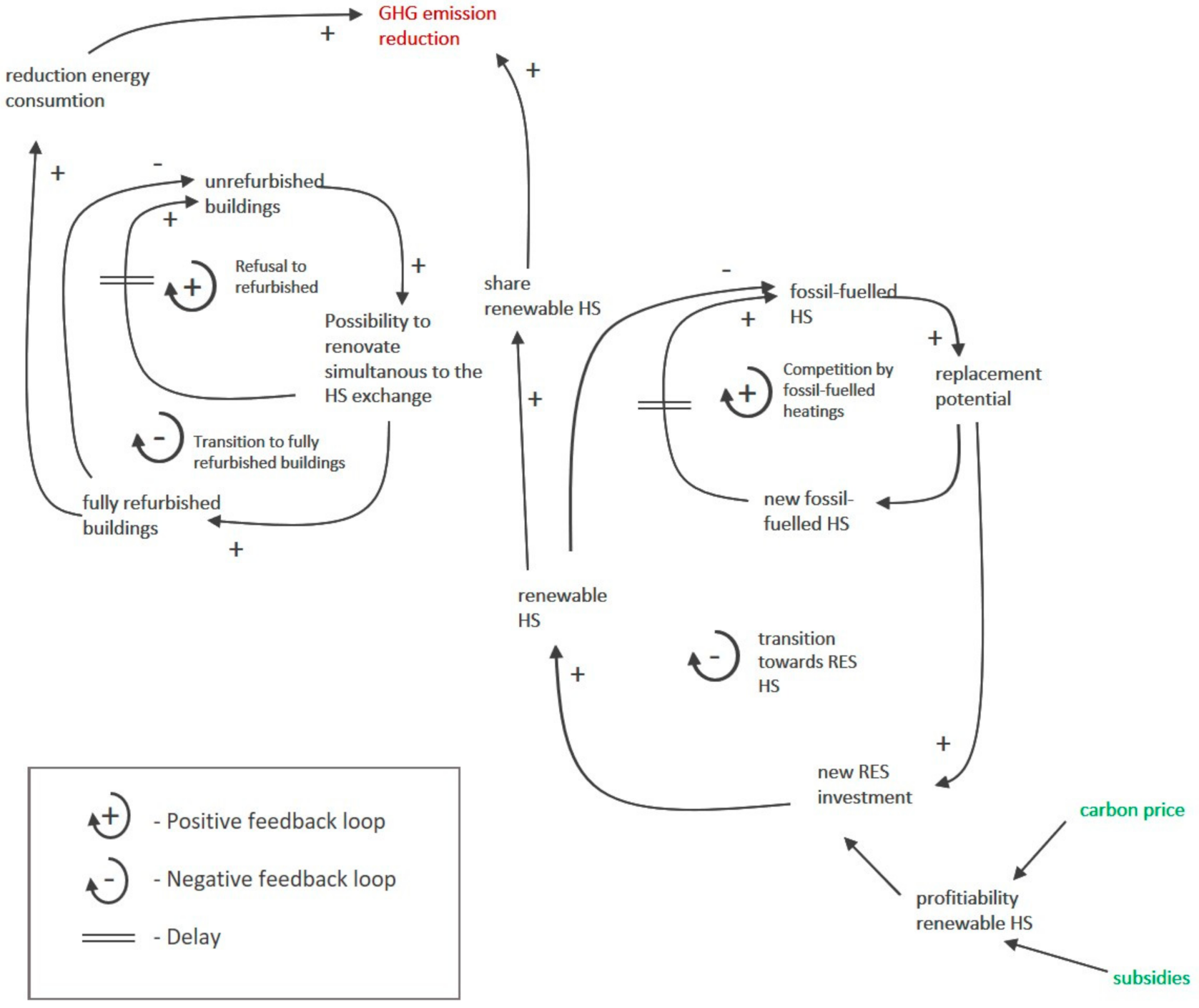
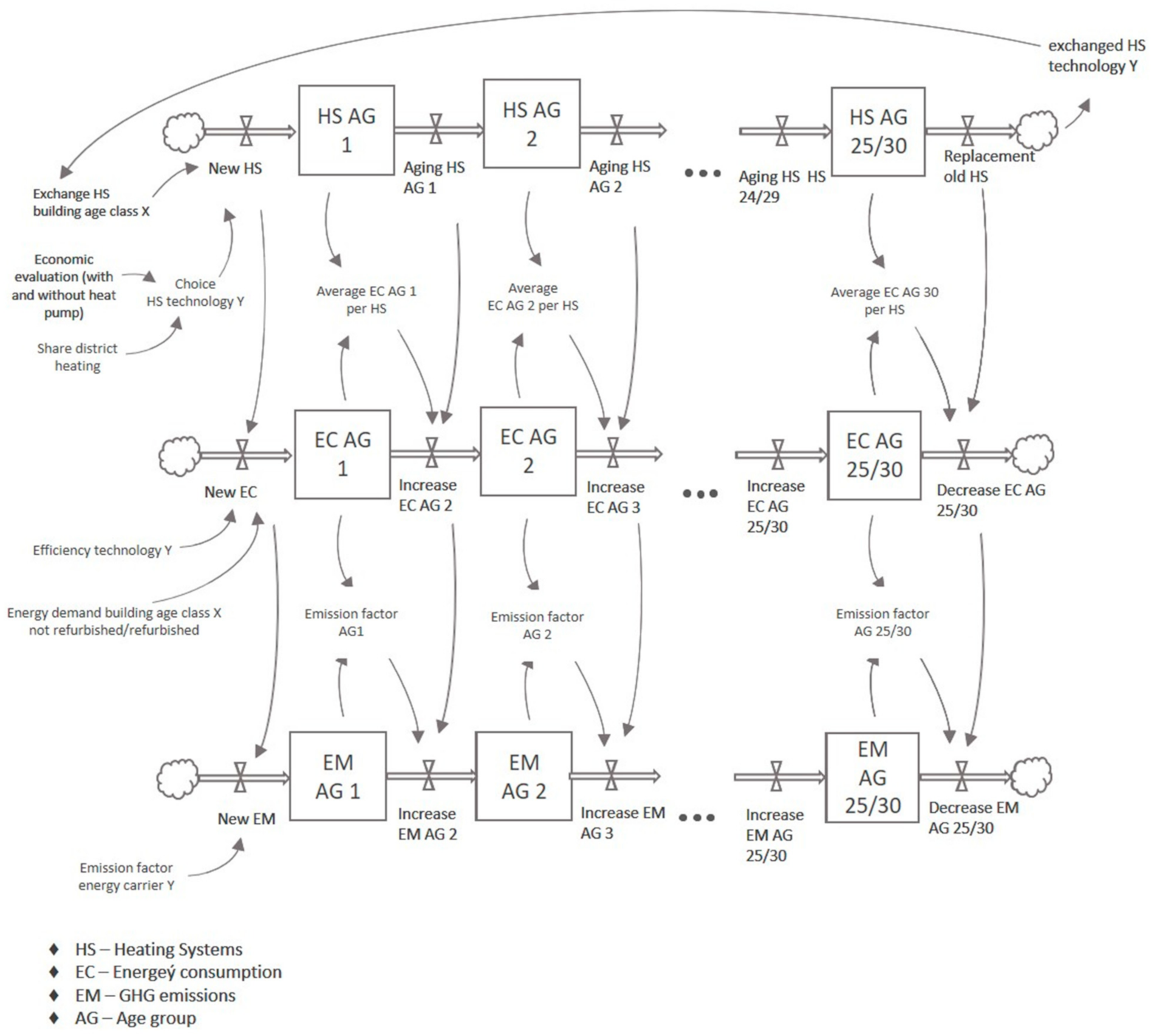
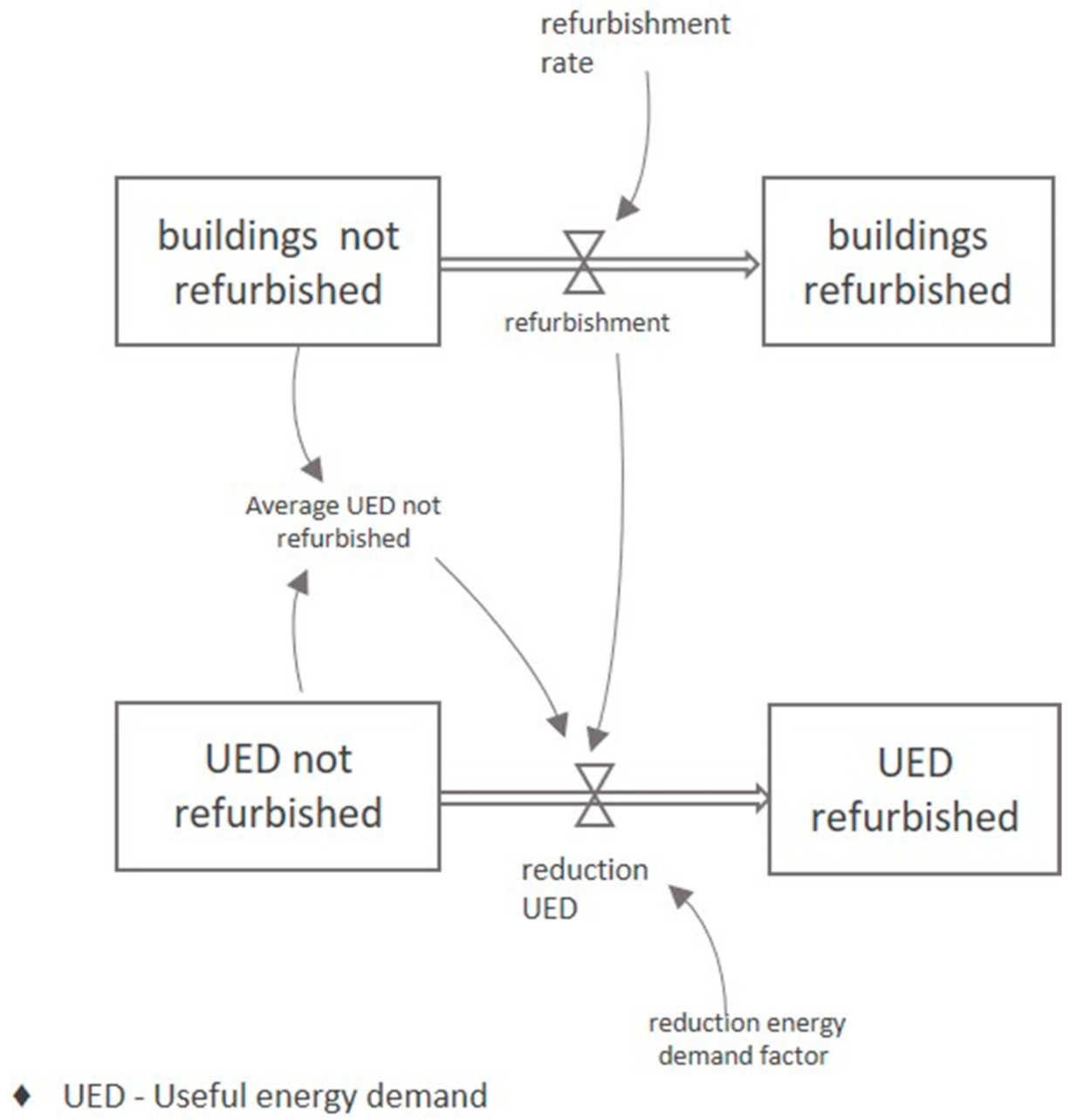
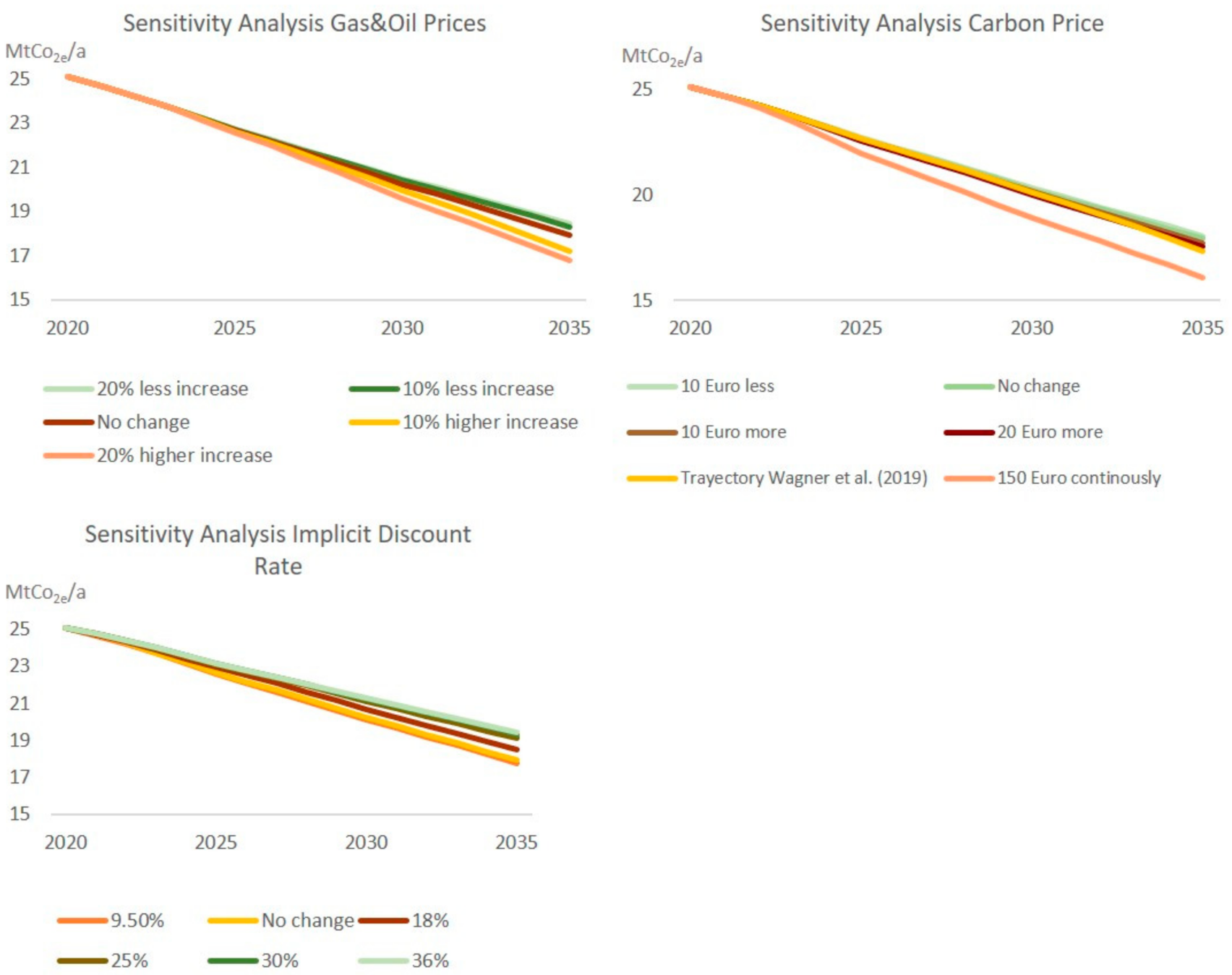
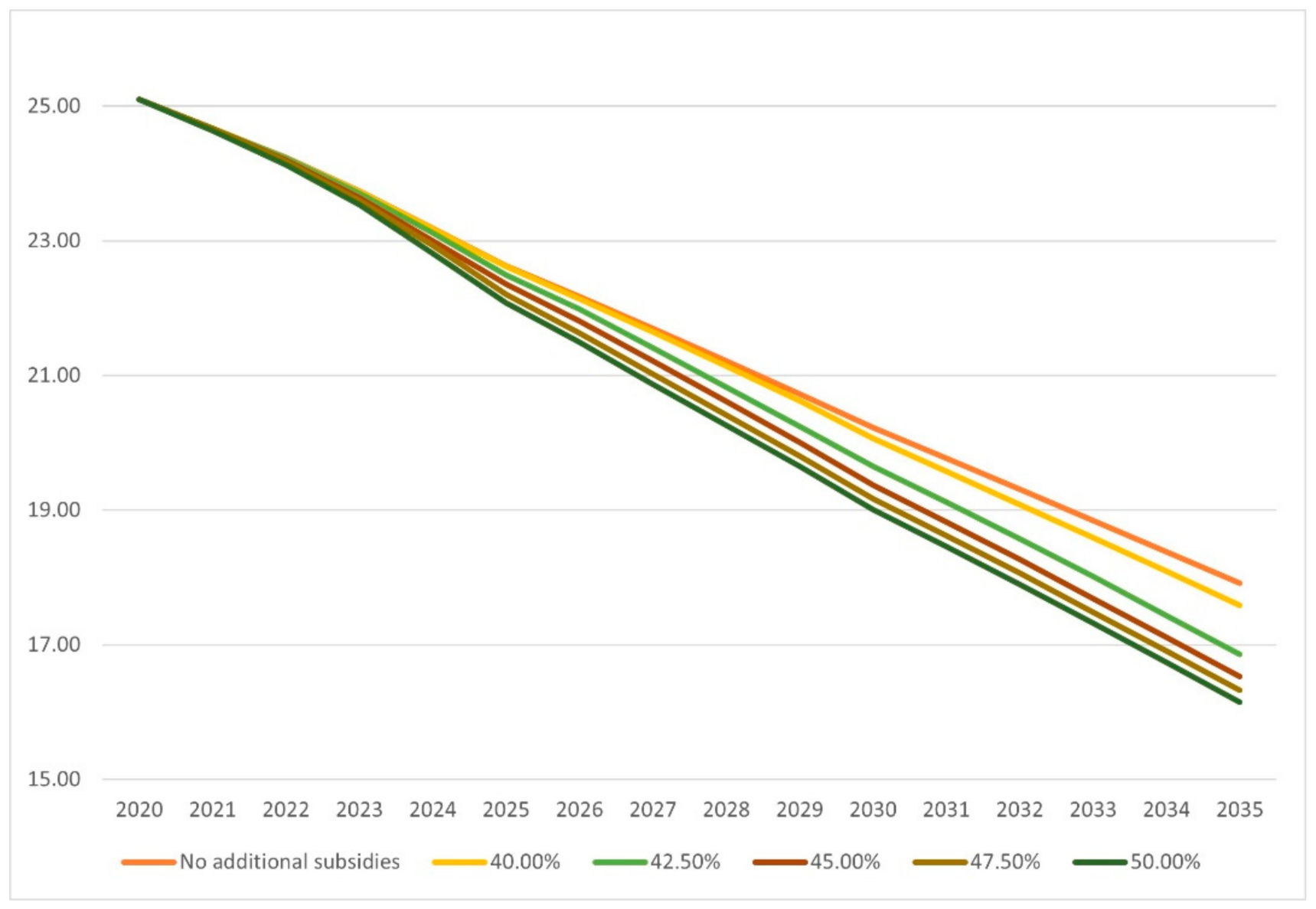
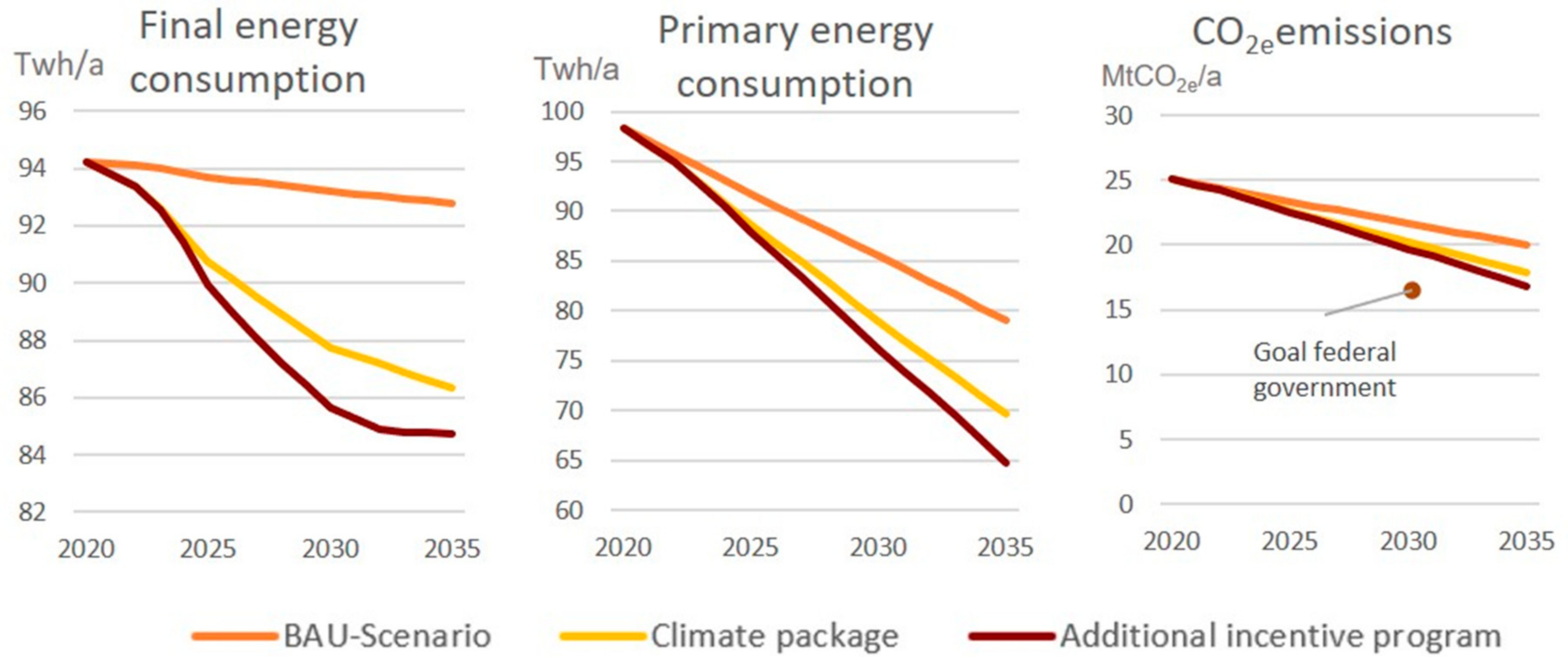
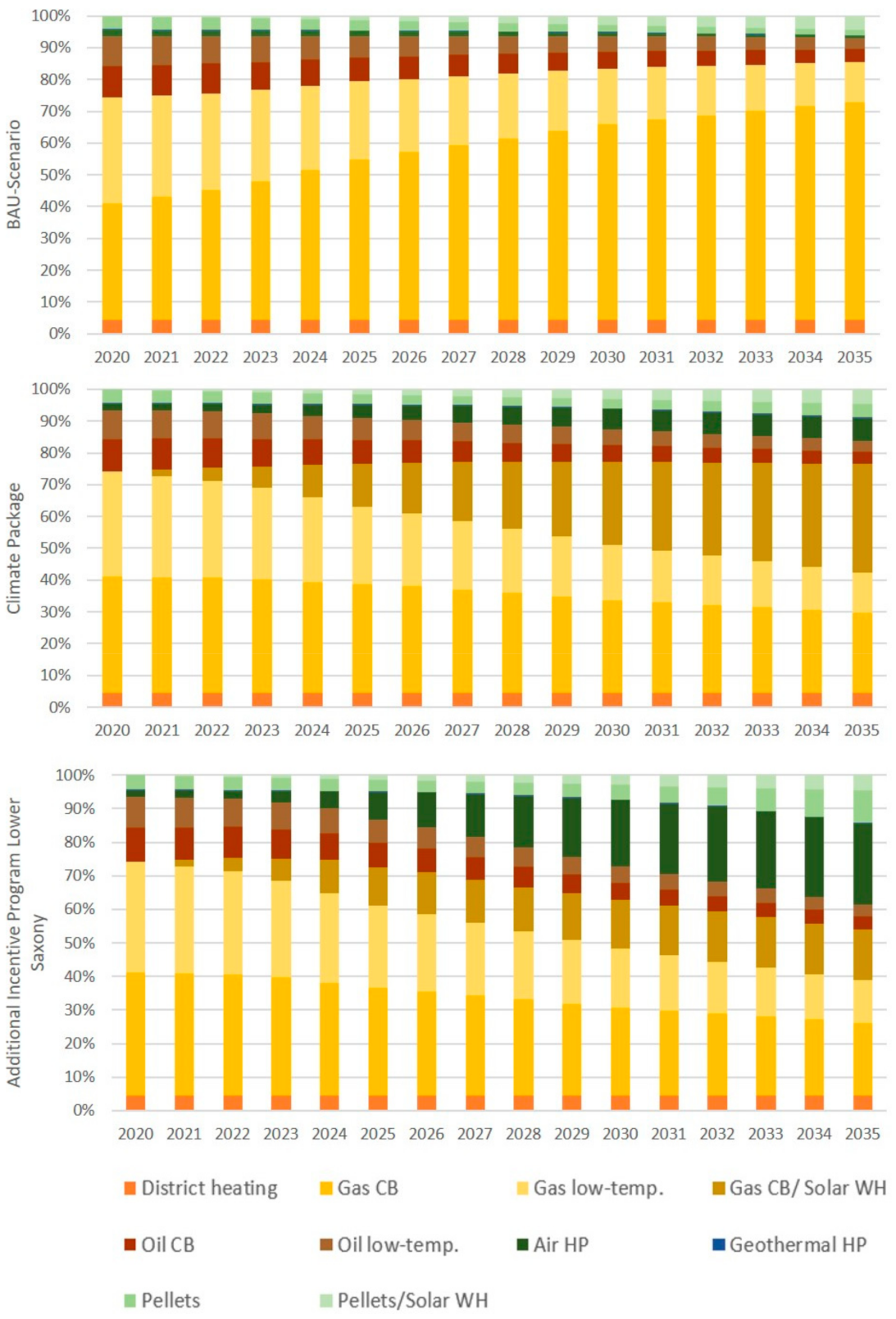
| Final Energy Consumption | Primary Energy Consumption | CO2e Emissions | ||||
|---|---|---|---|---|---|---|
| Change over the Simulated Timeframe (2020–2035) | Extrapolation to 2050 (Baseline Year: 2008) | Change over the Simulated Timeframe (2020–2035) | Extrapolation to 2050 (Baseline Year: 2008) | Change over the Simulated Timeframe (2020–2035) | Change until 2030 (Baseline Year: 2014) | |
| BAU- Scenario | −1.53% | −4.43% | −19.61% | −46.75% | −20.37% | −21.08% |
| Climate Package Scenario | −8.33% | −18.72% | −29.21% | −63.14% | −28.65% | −26.34% |
| ‘Additional incentive program’ Scenario | −10.07% | −23.78% | 34.11% | −71.27% | −32.85% | −28.43% |
Publisher’s Note: MDPI stays neutral with regard to jurisdictional claims in published maps and institutional affiliations. |
© 2021 by the authors. Licensee MDPI, Basel, Switzerland. This article is an open access article distributed under the terms and conditions of the Creative Commons Attribution (CC BY) license (https://creativecommons.org/licenses/by/4.0/).
Share and Cite
Haase, I.; Torio, H. The Impact of the Climate Action Programme 2030 and Federal State Measures on the Uptake of Renewable Heating Systems in Lower Saxony’s Building Stock. Energies 2021, 14, 2533. https://doi.org/10.3390/en14092533
Haase I, Torio H. The Impact of the Climate Action Programme 2030 and Federal State Measures on the Uptake of Renewable Heating Systems in Lower Saxony’s Building Stock. Energies. 2021; 14(9):2533. https://doi.org/10.3390/en14092533
Chicago/Turabian StyleHaase, Isabel, and Herena Torio. 2021. "The Impact of the Climate Action Programme 2030 and Federal State Measures on the Uptake of Renewable Heating Systems in Lower Saxony’s Building Stock" Energies 14, no. 9: 2533. https://doi.org/10.3390/en14092533
APA StyleHaase, I., & Torio, H. (2021). The Impact of the Climate Action Programme 2030 and Federal State Measures on the Uptake of Renewable Heating Systems in Lower Saxony’s Building Stock. Energies, 14(9), 2533. https://doi.org/10.3390/en14092533







